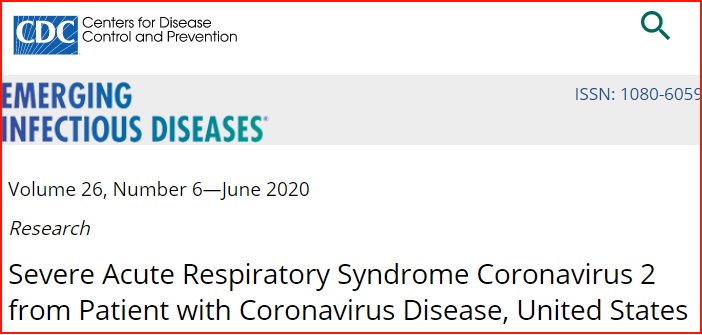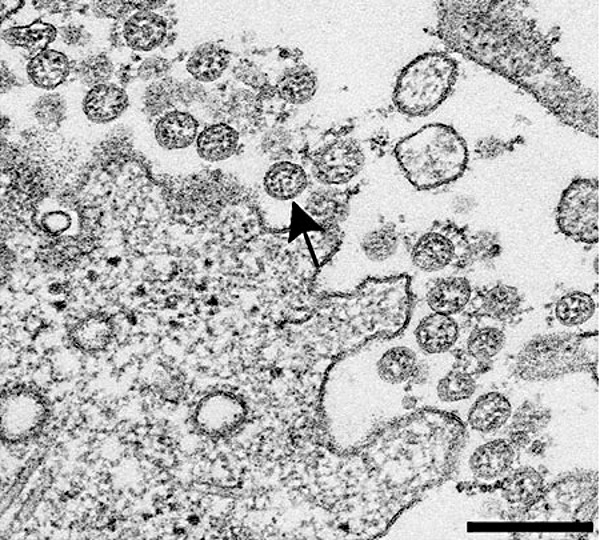
Warning Signs You’ve Been Tricked by Virologists
by Dr. Mark Bailey
Febuary 1, 2022

“Viruses are small obligate intracellular parasites, which by definition contain either a RNA or DNA genome surrounded by a protective, virus-coded protein coat.”
Medical Microbiology, 4th edition, 1996
The question regarding the existence of pathogenic viruses remains an important one as the belief in such viruses dictates billions of dollars of resources and research funds. In the past two years we have also seen how an alleged virus can be used as a political tool to bring populations to heel. It is not the first time this has happened: for example, the “discovery” of HIV in the 1980s set up a multi-billion dollar industry and has also been used politically in most corners of the world. (The fallacies regarding the existence of the HIV particle and it causing AIDS are outlined in Virus Mania. For those wanting to dive more deeply into the arguments, I would recommend The Perth Group’s magnus opus on this topic.)
Independent journalist Jeremy Hammond who promotes himself as exposing “dangerous state propaganda” surrounding COVID-19 and the dangers of the vaccines, thus made the following curious statement in 2021:
“the false claim that SARS-CoV-2 has never been isolated (i.e., never proven to exist) greatly harms the credibility of the health freedom movement and is grounded in total ignorance of the science (the virus is constantly being isolated and whole genome sequenced by scientists all over the world)”
Jeremy Hammond, 9 March 2021
I would argue that the ignorance falls in Hammond’s lap as he appears to reach his conclusion by essentially repeating the claims made by virologists and reassuring the audience that their methodologies are valid. In recent weeks we have also seen Dr Joseph Mercola presenting Hammond’s interview and Steve Kirsch’s blog (that also makes appeals to virology authority) as “evidence” that SARS-CoV-2 exists. Kirsch states that he relies on “expert opinions of people I trust” which means that he has put the argument into the hands of others rather than investigating the issue himself. But is it wise for these health freedom fighters who are battling establishment COVID “experts” to not also question the establishment virologists?
Dr Andy Kaufman produced a point by point refutation of Hammond’s support of modern virology’s “isolation” methodology here, while Dr Tom Cowan warned that we are just getting started with dismantling virology’s nonsense here. Dr Sam Bailey has published many videos covering the virus isolation issue – most of which have been banned from YouTube but can still be found on Odysee. Additionally, in an essay I co-authored with Dr John Bevan-Smith, we describe the first pillar of the COVID-19 fraud as virology’s misuse of the term “isolation”. In summary, because virologists were unable to physically isolate any viruses last century, they simply changed the definition of the word so that even virologists admit the term is now used loosely. A strange state of affairs when the scientific method calls for precise terminology.
My observation over the past two years has been that many scientists, doctors, and journalists are happy to jump over this “isolation” chasm and cite the “coronavirus genomes” deposited in databases as proof that the virus must exist. For example, Steve Kirsch writes in his blog that:
“I know that Sabine Hazan verified that the sequence of the virus obtained from ATCC matched exactly what she found in people who have the virus.”
Steve Kirsch, 10 January 2022
He cites Hazan’s paper “Detection of SARS-CoV-2 from patient fecal samples by whole genome sequencing” as the evidence for this statement. Kirsch admits that he doesn’t know how the genomes were created, but his…
“scientist friends seem happy with them. At $2,000 a shot, I don’t think they’d market the product if it was contaminated and useless. Am I wrong?”
Steve Kirsch, 10 January 2022
Unfortunately, he appears to have been duped by the high-tech façade of virology’s genomics genie where “viruses” are created from various detected genetic sequences. In fact, sometimes the sequences are not really detected at all, as Dr Stefan Lanka is exposing in what may be virology’s death blow.
We can use Hazan’s paper as an example of the flawed methodology used in creating these “virus genomes”. The research team obtained faecal samples from 14 participants and proceeded to see what genetic sequences they could detect in the samples. We strike the first issue in the ‘methods’ section when they state that “included throughout sample processing was the SARS-CoV-2 positive control from ATCC (Heat-inactivated SARS-CoV-2, VR-1986HK; strain 2019-nCoV/USA-WA1/2020)” How did they know that the sample contained the inactivated virus? Because the ATCC (American Type Culture Collection) claims that it does on their website where they state “this strain was originally isolated from a human case in Washington state and was deposited by the Centers for Disease Control and Prevention.” And how did the CDC know that they had the virus? Because they claimed they found it in this paper here.
-

But where was the virus?
Similarly misleading was the claim they “extracted nucleic acid from isolates”. They have implied that they have isolated a virus and that they know which RNA sequences came from inside it. However, this would require the alleged viral particles to be truly physically isolated by purification, which they failed to do. And I say alleged because even if they purified the particles, it would still have to be shown that they meet the definition of a virus – including being parasitic and the causal agent of disease – something that was not demonstrated by these authors or any others.
In any case, how did they know which genetic sequences belonged to the “virus” in the first place? They “designed 37 pairs of nested PCRs spanning the genome on the basis of the coronavirus reference sequence (GenBank accession no. NC045512).” And where did this “reference sequence” come from? This relates to Fan Wu, et al’s paper describing the 41-year-old man who was admitted to the Central Hospital of Wuhan on 26 December 2019 with bilateral pneumonia and despite no new clinical features, was said to have a condition that was later called “COVID-19”.
The specimen was of crude lung washings, so it contained a mixture of human cells and potentially all sorts of other micro-organisms and genetic fragments. They simply asserted that there was a virus in the brew. From this mixed sample they blindly generated tens of millions of different sequences and then put their software to work to see how they could fit them all together. To do this “fitting” the software searched for “contigs” or areas where different fragments appear to have overlapping sequences. Of the hundreds of thousands of hypothetical sequences generated in this fashion they identified that the longest “continuous” sequence the computer could create was about 30,000 bases long and concluded that this software creation must be the genome of the presumed new virus.
They thought this was the genome because their hypothetically generated 30,000 base sequence was 89.1% similar to, “a bat SARS-like coronavirus (CoV) isolate—bat SL-CoVZC45”. The “genome” for the bat CoV “isolate” was generated in 2018 after “19 degenerated PCR primer pairs were designed by multiple alignment of available SARS-CoV and bat SL-CoV sequences deposited in GenBank, targeting almost the full length of the genome.” So in other words, they already knew the sequence to look for based on sequences that had previously been deposited in GenBank. But how did the producers of these already deposited sequences know that they had found viral genomes? Welcome to the circular reasoning of modern virology.
To explain the loop that virologists appear to be trapped inside, this 2019 paper published in Virology is illustrative of the problem:
“Three main methods based on HTS [High-throughput sequencing] are currently used for viral whole-genome sequencing: metagenomic sequencing, target enrichment sequencing and PCR amplicon sequencing, each showing benefits and drawbacks (Houldcroft et al., 2017). In metagenomic sequencing, total DNA (and/or RNA) from a sample including host but also bacteria, viruses and fungi is extracted and sequenced. It is a simple and cost-effective approach, and it is the only approach not requiring reference sequences. Instead, the other two HTS approaches, target enrichment and amplicon sequencing, both depend on reference information to design baits or primers.”
Maurier F, et al, “A complete protocol for whole-genome sequencing of virus from clinical samples,” Virology, May 2019.
Essentially this gets to the root of the problem. The “viral” reference genomes are being created through metagenomic sequencing but this is done on crude specimens (such as lung washings or unpurified tissue cultures) and then declarations that the selected sequences are viral in origin. So already there are two problems: firstly, there was no step (i.e. purification) to show that the sequences come from inside “viruses” and secondly, as described above, the computer generated “genomes” are simply assembled hypothetical models from small genetic fragments, not something that has been proven to exist in nature as a whole 30,000 base sequence. However, these in silico models then effectively become the “virus” and an entity such as SARS-CoV-2 is created. Once the first of such a sequence is deposited on a database, the “virus” can be “found” by others through the same flawed metagenomic techniques. Or as stated in the Virology paper, it can be “found” through target enrichment and amplicon sequencing (usually PCR), but this requires you to have a reference sequence…that is, a template that was invented in silico by metagenomic sequencing where the provenance of the genetic fragments was unknown.
There is no part in the above process that establishes either:
1) the genetic composition of any imaged or imagined particles; or
2) the biological nature of such particles, i.e. what they actually do.
-

It’s a good-looking nano-particle alright, but what is it made of and what does it do?
So, now can we return to Hazan’s paper to see that it is a pointless exercise in virological nonsense. They state that along with their “SARS-CoV-2 positive control from ATCC”, the “patient genomes were compared to the Wuhan-Hu-1 (MN90847.3) SARS-CoV-2 reference genome”. Accession number MN90847.3 refers to the updated “genome” said to have been found in the 41-year-old man from Wuhan as discussed above in Fan Wu, et al’s paper. The circle is complete – at no stage was it demonstrated that there was any virus by following this evidence trail of “genomes”. Fan Wu’s team never found a virus, they simply asserted that their genetic sequence computer simulation was a “new RNA virus strain from the family Coronaviridae” without proving that the sequence existed in nature or came from inside a virus. Hence, there was no “detection of SARS-CoV-2 from patient fecal samples” as the title of the Hazan paper claimed, unless “SARS-CoV-2” means genetic sequences of who-knows-what from who-knows-where. It doesn’t matter where or how often these sequences are detected – they have never been proven to be viral in nature. So, when Steve Kirsch stated that Hazan “verified that the sequence of the virus obtained from ATCC matched exactly what she found in people who have the virus,” he is mistaken.
What “virus” is he talking about?

Truth Comes to Light highlights writers and video creators who ask the difficult questions while sharing their unique insights and visions.
Everything posted on this site is done in the spirit of conversation. Please do your own research and trust yourself when reading and giving consideration to anything that appears here or anywhere else.










